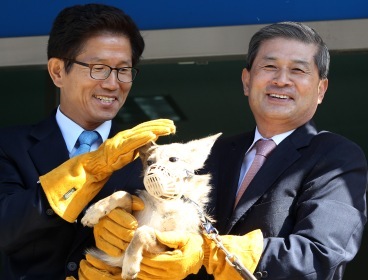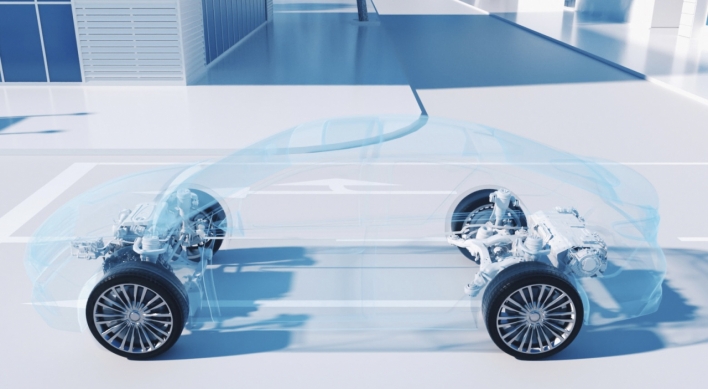SEOUL, Oct 17, 2011 (AFP) - Disgraced South Korean stem cell scientist Hwang Woo-Suk unveiled eight cloned coyotes Monday in a project sponsored by a provincial government.
Hwang delivered the clones to a wild animal shelter at Pyeongtaek, 50 kilometres (35 miles) south of Seoul, in a ceremony chaired by Gyeonggi province governor Kim Moon-Soo, Kim's office said.
Hwang was a national hero until some of his research into creating human stem cells from a cloned embryo was found to be faked.

But his work in creating Snuppy, the world's first cloned dog, in 2005 has been verified by experts and authorities.
Under a joint project with the province to clone wild animals, Hwang took cells from the skin of a coyote, Kim's office said in a statement.
He transplanted their nuclei into a dog's eggs from which the canine nucleus had been removed, it said, adding the first clone was born on June 17.
In a Twitter message, the governor praised Hwang for what he called the world's first use of such a technique. "The cloning of an African wild dog is under way, and we will attempt to clone a mammoth in the future," Kim said.
South Korean experts have previously cloned animals including a cow, a cat, dogs, a pig and a wolf. The cloned wolf died in 2009.
Hwang shot to fame in 2004 when he published a paper in the US journal Science claiming to have created the world's first stem-cell line from a cloned human embryo.
But his reputation was tarnished in November 2005 by allegations that he had violated medical ethics by accepting human eggs from his own researchers.
In January 2006 an investigative team ruled that his findings were faked and said he had produced no stem cells of any kind.
In 2009 Hwang received a two-year suspended sentence for embezzling research funds and ethical lapses in obtaining human eggs. Last December an appeals court reduced the penalty to an 18-month suspended sentence.
<한글기사>
황우석복귀.. '공룡복제해 쥬라기공원만든다'
황우석 박사 연구팀이 멸종위기에 처한 코요테 복제에 성공, 복제 코요테 8마리를 경기도에 기증했다.
황우석 수암생명공학연구원 책임연구원은 17일 오전 10시 30분 평택시 진위면에 있는 '경기도 축산위생연구소 야생동물구조센터'에서 김문수 경기지사에게 복제 코요테를 기증했다.
경기도가 기증받은 코요테 8마리는 황 박사 연구팀이 지난 6월 17일 1차 복제에 성공한 암컷 3마리와 2ㆍ3차 복제로 탄생한 수컷 5마리다.
황 박사팀은 코요테의 체세포를 개의 난자에 이식하는 체세포 핵이식방법으로 코요테 복제에 성공했다고 밝혔다.
이종간(異種) 사이의 체세포핵이식 기법을 이용해 코요테를 복제한 것은 세계적으로 처음이라는 것이 황 박사팀의 설명이다.
개과 동물인 코요테는 국제자원보존연맹(IUCN)에서 멸종위기등급 주의단계 동물로 지정돼 있다.
코요테와 같은 개과 동물은 독특한 생리특성상 다른 포유동물에 비해 체외수정,체세포복제 등의 보조생식술이 어려운 것으로 알려져 있다.
황 박사팀은 청주랜드에서 전시ㆍ사육중인 코요테의 피부에서 세포를 채취, 복제용 체세포로 배양했다.
배양된 체세포는 핵을 제거한 개의 난자에 이식, 이종간 복제배아를 만든 후 대리모 개의 자궁에 이식했다.
연구팀은 복제배아이식 후 30일이 지나고 나서 초음파 영상진단 기법으로 복제코요테의 임신사실을 확인했다.
황 박사 팀은 지난 2월 19일 1차 실험을 시작, 4월 22일 개체복원을 하고 57일만인 6월 17일 3마리, 다시 13일만인 6월 30일 5마리의 코요테를 자연분만으로 얻는데 성공했다.
경기도와 수암생명공학연구원은 지난 6월 멸종위기동물 체세포 복제생산에 관한연구협약을 맺고 복제된 코요테 생산은 수암생명공학연구원이, 사육과 분양은 경기도가 맡기로 했다.
이에 따라 황 박사팀이 복제한 코요테는 경기도가 맡아 사육ㆍ분양해 국내는 물론 외국 동물원에 기증하고 코요테 원서식지인 북아메리카에도 방사할 계획이다.
김문수 지사는 "복제 코요테 생산 성공은 멸종동물 보존과 국내 관광산업 수익증대라는 의미를 지닌다"면서 "코요테에 이어 아프리카 들개인 리카온 등 멸종위기
동물 복제와 보급에 도전할 생각"이라고 말했다.
황 박사팀은 지난해 12월 리카온 체세포 배양을 시작해 리카온 복제에 도전했으나 올해 6월과 8월 유산으로 실패했고 현재 3차 분만을 시도중이라고 도는 전했다.
경기도는 지난 2009년 8월 수암생명공학연구원과 형질전환 복제돼지 생산을 위한'바이오연구협력 MOU'를 맺고 황 박사팀에 연간 5천여만원 상당의 연구용 돼지와 사료비를 지원해왔다.
이번 복제 코요테 사육에는 연간 1천300여만원의 비용이 들어갈 것으로 경기도는 추산하고 있다.
김용삼 경기도 대변인은 "황 박사가 '논문 조작' 등의 일로 어려움을 겪을때 경기도가 지원해준 것에 대해 황 박사가 고마워하고 있다"면서 "이번 코요테 복제를 세계적으로 인정받기 위한 논문 준비가 진행중인 것으로 알고 있다"고 말했다.









![[Kim Seong-kon] Democracy and the future of South Korea](http://res.heraldm.com/phpwas/restmb_idxmake.php?idx=644&simg=/content/image/2024/04/16/20240416050802_0.jpg&u=)









![[Today’s K-pop] Zico drops snippet of collaboration with Jennie](http://res.heraldm.com/phpwas/restmb_idxmake.php?idx=642&simg=/content/image/2024/04/18/20240418050702_0.jpg&u=)